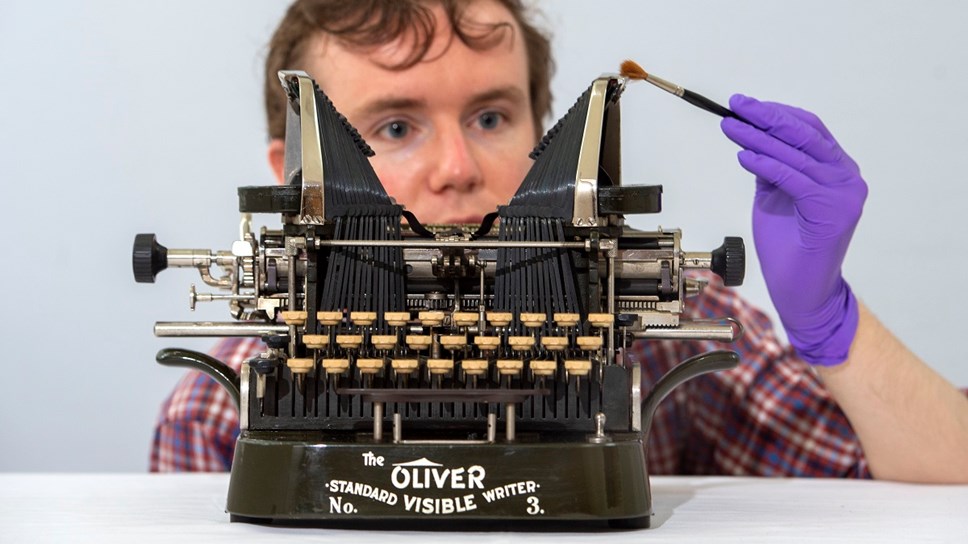
The Typewriter Revolution
A new exhibition at the National Museum of Scotland will examine the social and technological impact of typewriters over more than 100 years, from early prototypes to stylish mid-century models, which are still in use today.
The full image selection is available to download here.
The Typewriter Revolution charts the development of these iconic machines and explores their role in society, the arts and popular culture through the personal stories of those who designed, made and used them.
The Typewriter Revolution draws on National Museums Scotland’s significant typewriter collection, with highlights including an 1876 Sholes & Glidden typewriter which was the first to have a QWERTY keyboard, a 1950s electric machine used by Whisky Galore author Sir Compton Mackenzie, and the 1970s design icon, the Olivetti Valentine.
Alison Taubman, Principal Curator of Communications at National Museums Scotland said:
“The typewriter is a true icon. It revolutionised the workplace, transformed communications and inspired artists and writers. From the clatter of its keys to its unique aesthetic, the enduring romance surrounding the typewriter has earned it many devoted fans. This charming exhibition takes visitors on a journey from its inception as a curious piece of cutting-edge technology through its role as a crucial mainstay of the workplace right up to the present day, where it enjoys cult appeal.”
PhD student James Inglis brushing a Blickensderfer featherweight typewriter with a paintbrush
Typewriters were first shipped across the Atlantic by American firm E. Remington & Sons in the 1870s. They were luxury devices which cost the equivalent of half the average annual salary.
Sewing machine salesman John J. Deas was an early enthusiast. Adverts for his business in Dundee and Aberdeen claimed the typewriter would “do for the ink-bottle and the pen, what the sewing machine has done for the needle”.
The final decade of the 19th century saw a huge boom in the demand for typewriters as
organisations began to realise their value, and by 1900 they had revolutionised the world of
communications, transforming office work and opening up new employment opportunities,
especially for women.
They inspired novelists and artists, with Mark Twain among the first to use what he called a “new-fangled writing machine”. Henry James liked the loud clacking of a Remington typewriter and found that his inspiration dried up when he upgraded to a quieter model. Jack Kerouac typed out On The Road on a 36 metre-long manuscript because he wanted to write continuously.
In the late 1940s the Italian firm Olivetti opened a factory in the east end of Glasgow, later producing stylish models such as the Lexikon 80, and the portable Lettera 22 which were seen as the cutting-edge of design. Typewriter technology advanced to include electric models from the 1920s before the rise in computers saw them gradually phased out of offices. However, the unique experience of writing on a typewriter and the enduring beauty of their design mean there is still a demand for the machines.
National Museums Scotland has been awarded the UK-wide, industry standard “We’re Good To Go” accreditation. This means the museums have followed Government and public health guidelines, have carried out Covid-19 risk assessments and have the appropriate processes in place.
Notes to editors
Further information on exhibition and images from: Alice Wyllie, Press Office on 0131 247
4288 or email a.wyllie@nms.ac.uk
- National Museums Scotland is one of the leading museum groups in the UK and Europe and
it looks after collections of national and international importance. The organisation provides
loans, partnerships, research and training in Scotland and internationally. Our individual
museums are the National Museum of Scotland, the National Museum of Flight, the National
Museum of Rural Life and the National War Museum. The National Museums Collection
Centre in Edinburgh houses conservation and research facilities as well as collections not
currently on display.
Twitter: @NtlMuseumsScot
Facebook: www.facebook.com/NationalMuseumsScotland
Instagram: @NationalMuseumsScotland - Bheireadh Oifis nam Meadhanan eadar-theangachadh Gàidhlig den bhrath-naidheachd
seachad do bhuidhinn mheadhanan bharantaichte. Cuiribh fios do dh'Oifis nam Meadhanan
airson bruidhinn air cinn-latha freagarrach.
